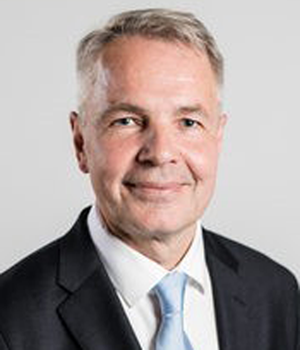No CrossRef data available.
Article contents
Interview with His Excellency Pekka Haavisto
Foreign Minister of Finland
Published online by Cambridge University Press: 27 October 2022
Abstract
 HE Pekka Haavisto is the Minister for Foreign Affairs of Finland. He was a Member of Parliament in 1983–95 and was returned to Parliament in 2007. He served as Minister of Development and the Environment in 1995–99, and as Minister for International Development in 2013–14. In 1993–95 and 2018–19, he was Party Leader of the Greens in Finland. He has also served several years as a member of the Helsinki City Council. He stood as a candidate in the presidential election in Finland in 2012 and in 2018.
HE Pekka Haavisto is the Minister for Foreign Affairs of Finland. He was a Member of Parliament in 1983–95 and was returned to Parliament in 2007. He served as Minister of Development and the Environment in 1995–99, and as Minister for International Development in 2013–14. In 1993–95 and 2018–19, he was Party Leader of the Greens in Finland. He has also served several years as a member of the Helsinki City Council. He stood as a candidate in the presidential election in Finland in 2012 and in 2018.
He has gained wide experience of various areas of foreign policy, for example while chairing the UN Environment Programme Task Forces on environmental impacts of war in the Balkans, Afghanistan, Iraq, Liberia, the Occupied Palestinian Territory and Sudan. He has also worked as the EU Special Representative for Sudan and Darfur, Special Adviser for the UN (ASG) in the Darfur peace process, and Special Representative to the Minister for Foreign Affairs in African crises. In addition, he has served in several positions of trust, including President of the Board of the European Institute of Peace in 2016–19, Chair of the Board of the Finnish Federation of Settlement Houses in 2014–19, and Chair of WWF Finland's Board of Trustees.
Mr Haavisto has worked as Editor-in-Chief of several publications, including Vihreä Lanka magazine. Additionally, he has authored many books, the most recent one, Eurooppa raiteilla (Europe on Rails), in 2018. He lives in a registered partnership, and his main interests are books, cycling, wooden boats and cultural backyards.
- Type
- Interview
- Information
- International Review of the Red Cross , Volume 105 , Issue 922: Persons with disabilities in armed conflict , April 2023 , pp. 38 - 44
- Copyright
- Copyright © The Author(s), 2022. Published by Cambridge University Press on behalf of the ICRC.
Footnotes
This interview was conducted by Bruno Demeyere, Editor-in-Chief of the Review, and Jillian Rafferty, Managing Editor of the Review, on 13 September 2022.
The advice, opinions and statements contained in this article are those of the author/s and do not necessarily reflect the views of the ICRC. The ICRC does not necessarily represent or endorse the accuracy or reliability of any advice, opinion, statement or other information provided in this article.
References
1 See the Abilis Foundation website, available at: www.abilis.fi/?lang=en.
2 Charter on Inclusion of Persons with Disabilities in Humanitarian Action, 2016, available at: http://humanitariandisabilitycharter.org/the-charter/.
3 Oslo, 16–17 February 2022.
4 2022 Global Disability Summit Commitments, available at: www.globaldisabilitysummit.org/commitments.


